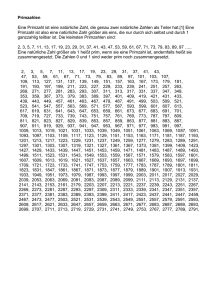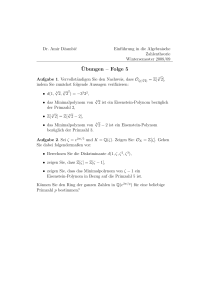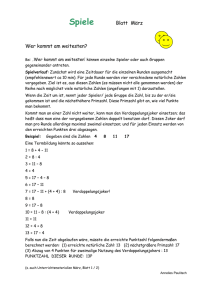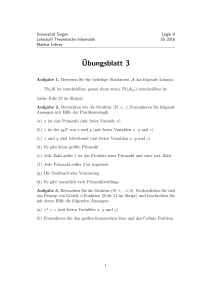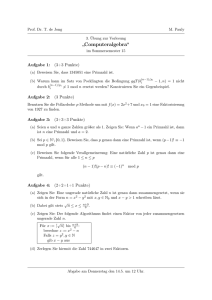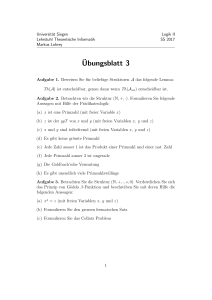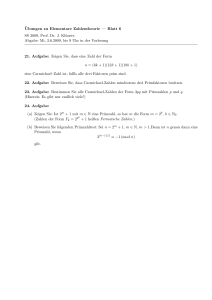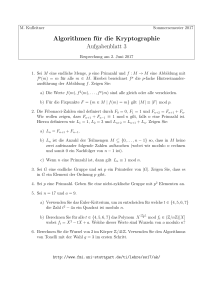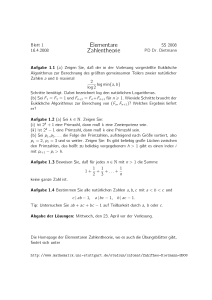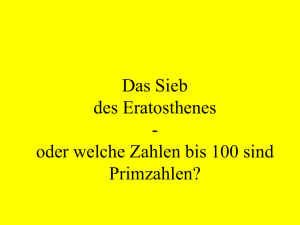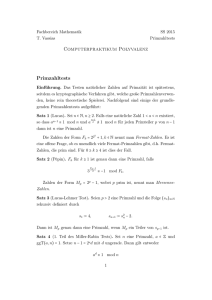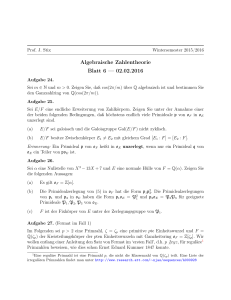2.5 Zahlen und Zahldarstellungen
Werbung
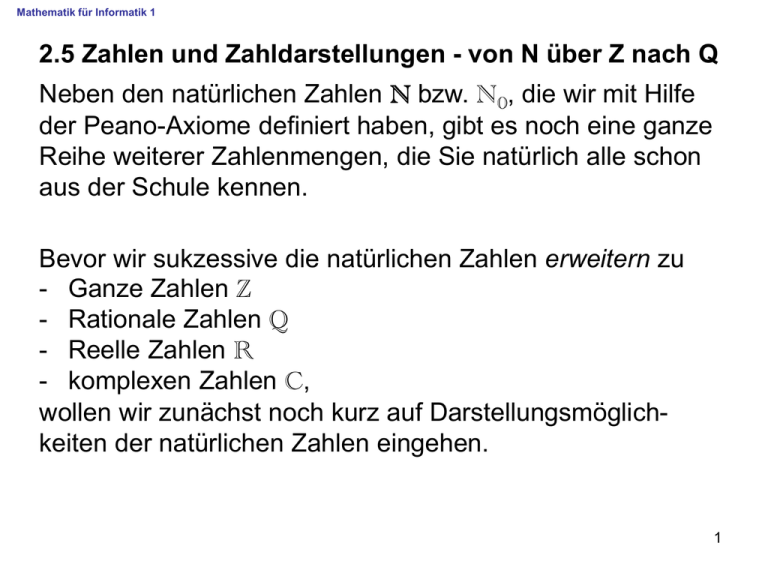
Mathematik für Informatik 1 2.5 Zahlen und Zahldarstellungen - von N über Z nach Q Neben den natürlichen Zahlen N bzw. N0, die wir mit Hilfe der Peano-Axiome definiert haben, gibt es noch eine ganze Reihe weiterer Zahlenmengen, die Sie natürlich alle schon aus der Schule kennen. Bevor wir sukzessive die natürlichen Zahlen erweitern zu - Ganze Zahlen Z - Rationale Zahlen Q - Reelle Zahlen R - komplexen Zahlen C, wollen wir zunächst noch kurz auf Darstellungsmöglichkeiten der natürlichen Zahlen eingehen. 1 Mathematik für Informatik 1 Wir haben bereits die Primzahlen kennengelernt und können sie mit Hilfe einer Quantoren-Darstellung (∀, ∃ ) definieren : Beispiel 8 p prim : ⇔ [ ( ∀ k ∈ N : k |* p ) ⇒ ( k = 1 ) ∨ ( k = p )] ∗lies: k teilt p. Die Primzahlen erweisen sich in gewisser (multiplikativer) Weise als Grundbausteine der natürlichen Zahlen: 2 Mathematik für Informatik 1 Satz 7 : Jede natürliche Zahl n ≥ 2 kann als Produkt aus einer Primzahl p und einer natürlichen Zahl a ∈ N, also in der Form n = p ・ a dargestellt werden. Beweisskizze: Alle Primzahlen erfüllen den Satz offenbar mit a = 1. Eine Zahl n ∈ N, die keine Primzahl ist, lässt sich folglich als Produkt n = a ・ b zweier Zahlen a > 1 und a < n bzw. b > 1 und b < n schreiben. Da es nur n−1 viele natürliche Zahlen gibt, die kleiner als n sind, ist n nur auf endliche viele verschiedene Arten als Produkt von zwei natürlichen Zahlen (die größer als 1 sind) darstellbar. Als endliche Menge dieser Faktoren muss es einen kleinsten Faktor p geben. Wir zeigen nun, dass p eine Primzahl sein muss, mit Hilfe eines indirekten Beweises: D.h. wir nehmen an, dass p keine Primzahl sei (also das Gegenteil von dem, was wir beweisen wollen) und leiten daraus einen Widerspruch her. Wenn p keine Primzahl wäre, müsste es wieder Zahlen c und d geben, die jeweils echt größer als 1 und diesmal jeweils echt kleiner als p wären, 1 < c < p und 1 < d < p und für die p = c ・ d gelten würde. Damit wäre n = p ・ a = (c ・ d) ・ a = c ・ (d ・ a) , da aber p der kleinste Faktor gewesen sein sollte, müsste daraus also p ≥ c folgen, was aber im Widerspruch zu p < c steht, sodass unsere Annahme, dass p keine Primzahl ist, falsch gewesen sein muss. 3 Mathematik für Informatik 1 Beispiel 32 : Dass es durchaus verschiedene solcher Zerlegungen in ein Produkt einer Primzahl und einer Zahl größer als 1 geben kann, sehen wir z.B. für n = 144 an den beiden Zerlegungen 144 = 2 ・ 72 = 3 ・ 48 . Allerdings können wir den Satz, sobald wir die kleinstmögliche Primzahl p bestimmt haben, auf die damit erhaltene natürliche Zahl a > 1 anwenden und eine Zerlegung dieser Zahl finden, sofern diese keine Primzahl war (im obigen Beispiel also auf 72). 4 Mathematik für Informatik 1 5 Mathematik für Informatik 1 6 Mathematik für Informatik 1 7 Mathematik für Informatik 1 8 Mathematik für Informatik 1 9 Mathematik für Informatik 1 10 Mathematik für Informatik 1 11 Mathematik für Informatik 1 12 Mathematik für Informatik 1 13 Mathematik für Informatik 1 14 Mathematik für Informatik 1 15 Mathematik für Informatik 1 16 Mathematik für Informatik 1 17 Mathematik für Informatik 1 18 Mathematik für Informatik 1 19 Mathematik für Informatik 1 20 Mathematik für Informatik 1 21 Mathematik für Informatik 1 22 Mathematik für Informatik 1 23 Mathematik für Informatik 1 24 Mathematik für Informatik 1 25 Mathematik für Informatik 1 26 Mathematik für Informatik 1 27 Mathematik für Informatik 1 28 Mathematik für Informatik 1 29 Mathematik für Informatik 1 30 Mathematik für Informatik 1 31 Mathematik für Informatik 1 32 Mathematik für Informatik 1 33 Mathematik für Informatik 1 34 Mathematik für Informatik 1 35 Mathematik für Informatik 1 36 Mathematik für Informatik 1 37 Mathematik für Informatik 1 38 Mathematik für Informatik 1 39 Mathematik für Informatik 1 40 Mathematik für Informatik 1 41 Mathematik für Informatik 1 42 Mathematik für Informatik 1 43 Mathematik für Informatik 1 44 Mathematik für Informatik 1 45 Mathematik für Informatik 1 46 Mathematik für Informatik 1 47 Mathematik für Informatik 1 48 Mathematik für Informatik 1 49 Mathematik für Informatik 1 50 Mathematik für Informatik 1 51
